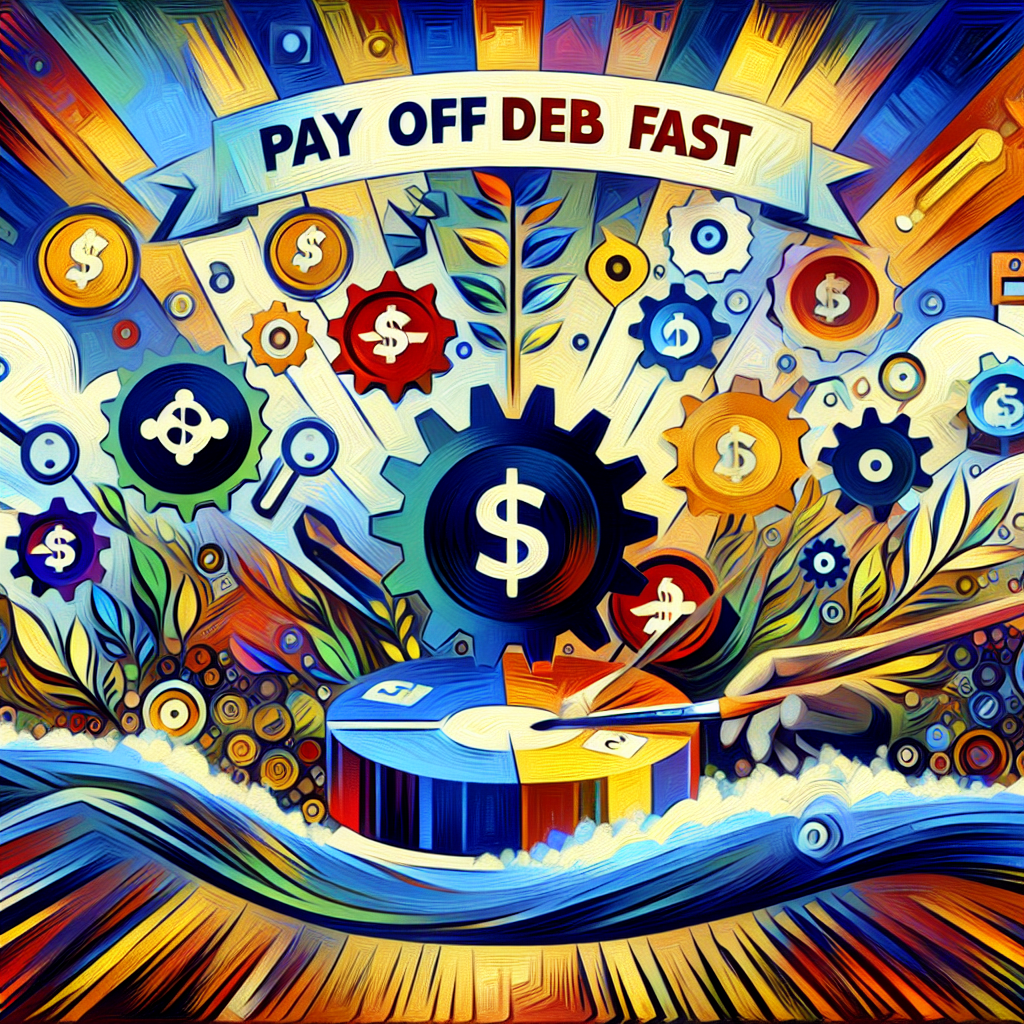Pay Off Debt Fast

“Unlock Financial Freedom: Accelerate Your Journey to a Debt-Free Life!”
Paying off debt fast is a financial strategy that involves allocating extra resources towards outstanding debts to eliminate them more quickly than by making only the minimum payments. This approach can save money on interest, reduce financial stress, and improve credit scores. It often requires a combination of budgeting, cutting expenses, and possibly increasing income. Strategies like the debt snowball or debt avalanche methods are commonly used to prioritize and systematically pay down debts. The goal is to become debt-free and achieve financial freedom sooner.
Ready to tackle your debt head-on and achieve financial freedom? Take the first step towards paying off your debt quickly by visiting our site for instant approval on personal loans tailored to help you clear your balances faster. Act now and start your journey to a debt-free life!
5 Proven Strategies to Pay Off Debt Fast: A Step-by-Step Guide
Title: Pay Off Debt Fast
In the realm of personal finance, debt stands as a formidable barrier to achieving financial freedom. The journey to pay off debt swiftly is not only a financial challenge but also a test of discipline and strategic planning. To navigate this journey successfully, one must employ proven strategies that can accelerate the process and lead to a debt-free life. This step-by-step guide outlines five such strategies that have been tried and tested by countless individuals seeking to regain control of their financial health.
The first strategy is the debt snowball method, which involves listing all debts from smallest to largest, regardless of interest rate. The focus is on paying off the smallest debt first while making minimum payments on the others. Once the smallest debt is paid off, the funds used for that debt are then rolled over to the next smallest debt, creating a ‘snowball effect’ as each debt is eliminated. This method provides psychological wins that can motivate individuals to maintain their debt repayment momentum.
Conversely, the debt avalanche method prioritizes debts by interest rate, targeting the debt with the highest rate first. This approach can save money over time, as it reduces the amount of interest paid. By focusing on the most expensive debts, one can minimize the overall interest burden, which can be a significant factor in the total repayment amount. Although this method may not provide the immediate gratification of paying off smaller debts first, it is financially efficient and can lead to faster debt reduction in the long term.
Another effective strategy is to increase income specifically for debt repayment. This can be achieved through various means such as taking on a part-time job, freelancing, selling unused items, or any other side hustle. The additional income generated can be directed entirely towards debt repayment, accelerating the process. It is crucial to remain disciplined and ensure that the extra income does not lead to increased spending but is used solely for the purpose of paying off debt.
A fourth strategy involves cutting expenses to free up more money for debt repayment. This requires a thorough review of one’s budget to identify areas where spending can be reduced. Simple changes such as cooking at home instead of dining out, canceling unused subscriptions, or opting for more affordable entertainment options can result in significant savings. Every dollar saved can be redirected towards debt repayment, making a noticeable impact over time.
Lastly, considering debt consolidation can be a wise move for those juggling multiple high-interest debts. Debt consolidation involves taking out a new loan with a lower interest rate to pay off existing debts. This can simplify the repayment process by combining multiple payments into one and can potentially lower the overall interest rate, making it easier to pay off the debt faster. However, it is important to carefully evaluate the terms of the consolidation loan to ensure that it truly benefits one’s financial situation.
In conclusion, paying off debt requires a well-thought-out strategy and a commitment to follow through. Whether one chooses the debt snowball or avalanche method, increases income, reduces expenses, or opts for debt consolidation, the key is to remain focused and consistent. By employing these proven strategies, individuals can make significant strides towards eliminating debt and achieving financial stability. Remember, the path to a debt-free life is not a sprint but a marathon that requires patience, perseverance, and a proactive approach.
The Snowball Method: Your Blueprint to Pay Off Debt Fast

The Snowball Method: Your Blueprint to Pay Off Debt Fast
In the realm of personal finance, debt repayment stands as a formidable challenge for many individuals. The journey to financial freedom is often fraught with obstacles, but with a strategic approach, it is possible to navigate this path with confidence. Among the various strategies available, the Snowball Method has emerged as a particularly effective blueprint for those seeking to pay off debt swiftly and efficiently.
The Snowball Method, conceptualized on the principle of momentum, advocates for paying off debts from the smallest to the largest, regardless of interest rates. This method begins with a thorough inventory of all outstanding debts, listing them from the least to the greatest amount owed. The individual then focuses on allocating extra payments towards the smallest debt while maintaining minimum payments on all others. Once the smallest debt is extinguished, the funds that were previously directed to that debt are rolled over to the next smallest balance, thus creating a ‘snowball’ effect as one moves through their list of debts.
This approach is grounded in behavioral psychology. By targeting the smallest debts first, individuals can experience quick wins, which are essential for building motivation and a sense of accomplishment. These early victories serve as tangible proof of progress, reinforcing the individual’s commitment to their debt repayment plan. As each debt is paid off, the satisfaction derived from these achievements fuels the drive to tackle the next debt with increased vigor.
Moreover, the Snowball Method simplifies the debt repayment process. Instead of being overwhelmed by multiple debts, the individual can concentrate their efforts on one debt at a time, making the task seem more manageable. This focus reduces the cognitive load and decision fatigue that often accompany complex financial decisions, allowing for a more sustained and dedicated effort towards debt reduction.
Critics of the Snowball Method point out that it may not always be the most cost-effective strategy, particularly when higher-interest debts are left for later in the repayment process. In such cases, the Avalanche Method, which prioritizes debts with the highest interest rates, may save more money over time. However, the psychological benefits of the Snowball Method can outweigh the potential financial drawbacks for many individuals. The sense of progress and control that comes from eliminating debts one by one can be invaluable in maintaining the discipline required for long-term debt reduction.
It is important to note that the success of the Snowball Method, like any debt repayment strategy, hinges on the individual’s commitment to avoiding new debt while paying off existing obligations. This often requires lifestyle adjustments and a strict budget to free up additional funds for debt repayment. Additionally, an emergency fund is crucial to prevent the need for new borrowing in case of unexpected expenses.
In conclusion, the Snowball Method offers a structured and psychologically rewarding approach to debt repayment. By focusing on small, manageable goals and building momentum with each success, individuals can accelerate their journey towards a debt-free life. While it may not be the most cost-efficient method in every scenario, the motivational boost it provides can be the key to consistent and effective debt reduction. As with any financial strategy, personal circumstances and preferences should guide the choice of method, but for those who thrive on quick wins and clear progress, the Snowball Method stands as a compelling blueprint to Pay Off Debt Fast.
Cutting Expenses vs. Earning More: What’s the Best Way to Pay Off Debt Fast?
Title: Pay Off Debt Fast
When it comes to paying off debt quickly, individuals often find themselves at a crossroads, deciding whether to focus on cutting expenses or earning more income. Both strategies have their merits and can be effective in accelerating the debt repayment process. However, the best approach may vary depending on personal circumstances, financial goals, and the nature of the debt itself.
Cutting expenses is a straightforward strategy that involves scrutinizing one’s budget to identify and eliminate non-essential spending. This method is particularly appealing because it can be implemented immediately and does not require one to acquire new skills or additional employment. By reducing monthly outgoings, individuals can free up more cash to allocate towards debt repayment. This not only helps to pay down the principal faster but also reduces the amount of interest accrued over time, potentially saving a significant amount of money.
Moreover, adopting a frugal lifestyle can instill valuable financial habits that last well beyond the period of debt repayment. It encourages a mindset of living within one’s means and can lead to a more sustainable financial future. However, there is a limit to how much one can cut back on expenses without impacting the quality of life. Essential costs such as housing, utilities, and healthcare cannot be eliminated and may only offer minimal savings when optimized.
On the other hand, earning more income presents an opportunity to tackle debt without necessarily compromising one’s current standard of living. This can be achieved through a variety of means such as taking on a part-time job, freelancing, selling unused items, or pursuing a higher-paying position. Increasing income has the potential to make a significant impact on debt repayment because it can provide a substantial boost to the amount of money available each month to pay off debts.
Additionally, earning more can have long-term career benefits, such as gaining new skills or networking opportunities, which could lead to further income increases down the line. However, it’s important to consider the time commitment and potential stress associated with working more hours or balancing multiple jobs. The additional income must also be directed responsibly towards debt repayment rather than leading to lifestyle inflation.
In practice, the most effective way to Pay Off Debt Fast is often a combination of both cutting expenses and earning more income. By simultaneously reducing spending and increasing earnings, individuals can create a powerful financial strategy that maximizes the amount of money available for debt repayment. This dual approach can lead to quicker progress and a greater sense of control over one’s financial situation.
It is also crucial to prioritize debts, typically by interest rate, paying off high-interest debts first to reduce the total interest paid over time. This method, known as the debt avalanche, can be complemented by the debt snowball method, which focuses on paying off the smallest debts first for psychological wins that motivate continued debt repayment efforts.
Ultimately, the best way to Pay Off Debt Fast is a personalized approach that considers one’s unique financial picture. It requires discipline, commitment, and a willingness to make temporary sacrifices for long-term gain. Whether through cutting expenses, earning more, or a blend of both, the goal remains clear: to free oneself from the burden of debt and move towards a more secure financial future.
Q&A
1. What are some strategies to pay off debt quickly?
– Pay more than the minimum payment on debts.
– Use the debt snowball or avalanche method.
– Consolidate debts to a lower interest rate.
– Create a strict budget to free up money for debt repayment.
– Find additional sources of income to dedicate to debt repayment.
2. How does the debt snowball method work?
– List all debts from smallest to largest by balance.
– Make minimum payments on all debts except the smallest.
– Pay as much as possible on the smallest debt until it’s paid off.
– Once the smallest debt is paid, roll the payment amount into the next smallest debt.
– Repeat the process until all debts are paid off.
3. What is debt consolidation and how can it help pay off debt faster?
– Debt consolidation involves combining multiple debts into one single debt with a lower interest rate.
– It simplifies payments by having only one monthly payment instead of multiple.
– A lower interest rate means more of the payment goes towards the principal, potentially speeding up the payoff process.
– It can also lower monthly payments, although this may extend the repayment period if not managed properly.Conclusion: Paying off debt quickly can lead to significant financial benefits, including reduced interest payments, improved credit scores, and increased financial security. It can also provide psychological benefits, such as reduced stress and a sense of accomplishment. Strategies to Pay Off Debt Fast include prioritizing debts with the highest interest rates, creating a strict budget to free up more money for debt repayment, and considering debt consolidation or balance transfers to lower interest rates. It’s important to maintain a sustainable plan that doesn’t compromise essential living expenses or emergency savings.



